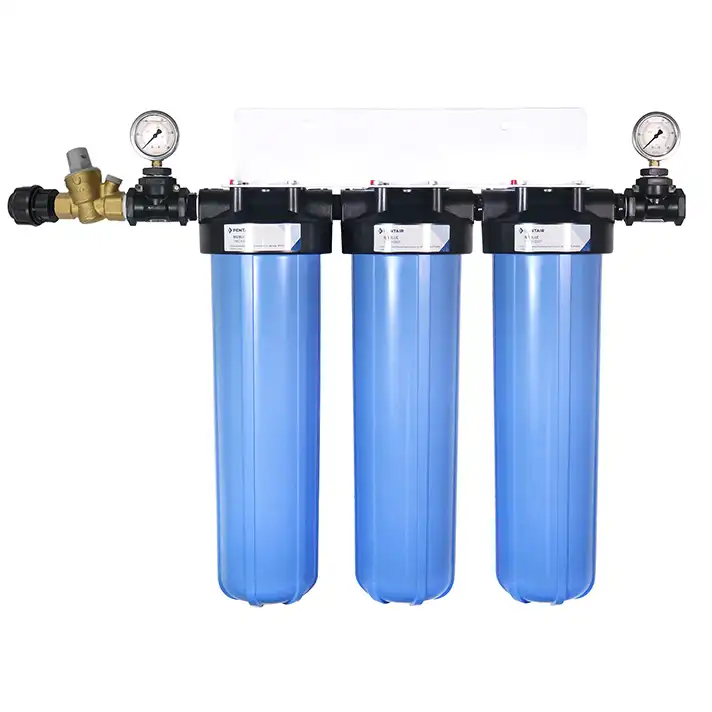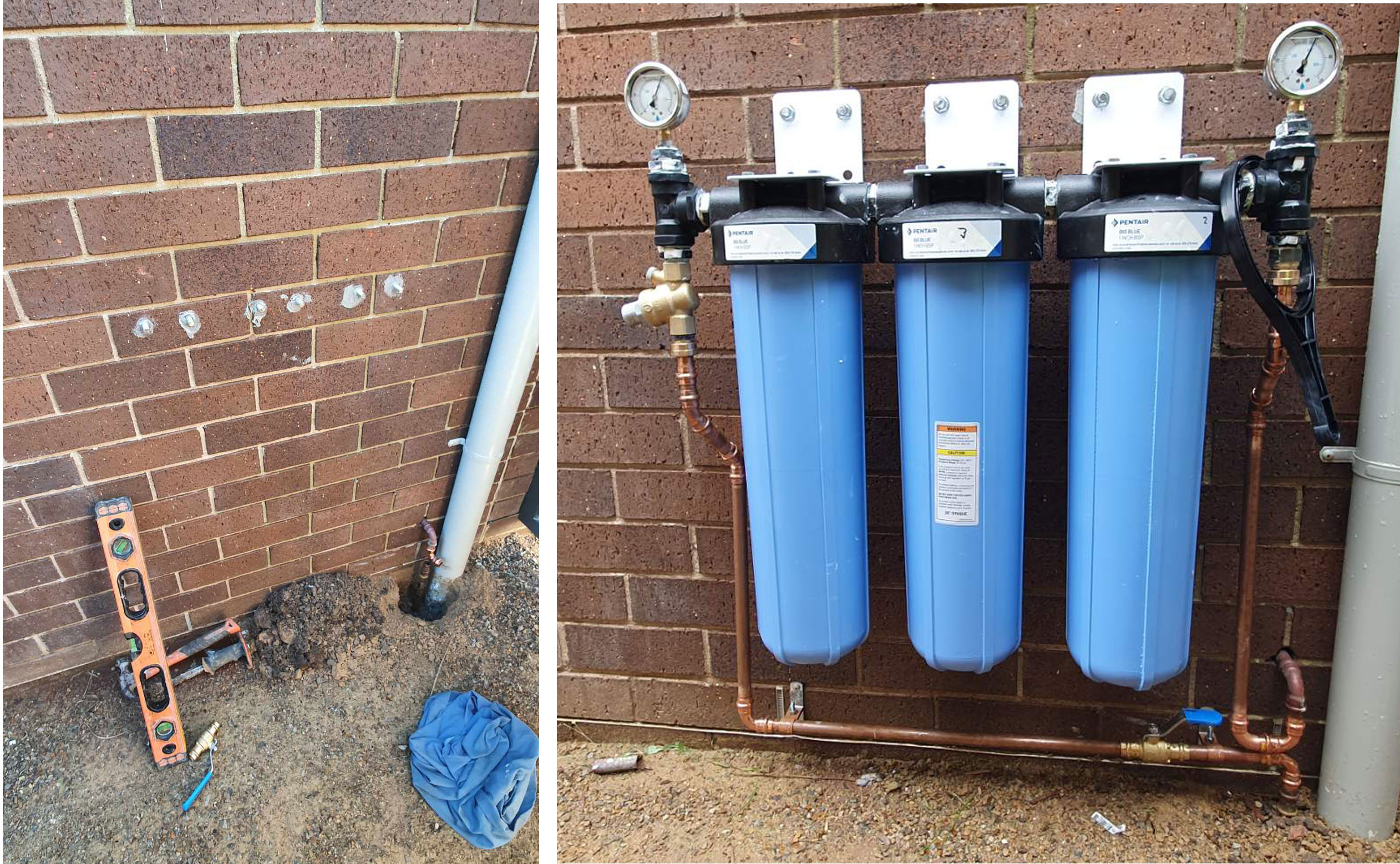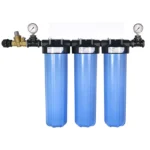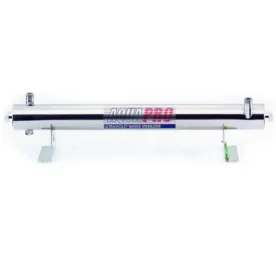This system comes with three filters:
- 1-micron Sediment Filter
- 20 Micron Radial Granular Activated Carbon (GAC) Filter
- Ultra-D Sub-micron Filter
These filters are housed in two 20-inch, commercial-grade filter casings and come complete with all the necessary fittings for connection to your existing plumbing.
Review our installation manual
Filter 1: 1-micron (Nominal) Sediment Filter
A 1-micron (Nominal) sediment filter is used to remove fine particles, such as dirt, sand, silt, and rust, from water. Here’s how it works and its purpose:
- Particle Removal: The “1-micron” rating indicates that the filter can remove particles as small as 1 micron in size. For reference, a human hair is about 70 microns in diameter, so this filter is highly effective at capturing fine sediment.
- Nominal Rating: A “nominal” rating means the filter will remove about 85-90% of particles that are 1 micron in size.
- Improves Water Quality: By removing sediment, the filter helps improve the taste, clarity, and quality of water, making it better for drinking, bathing, or even use in appliances.
Why It Matters:
-
Protects your main water filter (e.g., UltraStream) from clogging or damage
-
Improves water clarity and taste
-
Reduces wear on plumbing and appliances
-
Essential first stage for any multi-stage filtration system
Filter 2: 20-micron Radial Granular Activated Carbon (GAC) Filter
A 20-micron Radial Granular Activated Carbon (GAC) filter is designed to improve water quality by using activated carbon to remove impurities and a 20-micron filter to catch larger particles. Here’s how it works and what it’s for:
- 20-Micron Rating:
- The “20-micron” size indicates that the filter captures particles as large as 20 microns. This includes larger sediment like sand, dirt, or rust, but not as fine as smaller micron filters.
- Radial Design:
- A radial design refers to the filter’s shape, allowing water to flow through the entire surface area of the carbon media, increasing contact time and filtration efficiency. This design enhances water flow while still ensuring the carbon absorbs contaminants.
- Granular Activated Carbon (GAC):
- Activated carbon is highly porous and adsorbs (binds to) contaminants such as chlorine, volatile organic compounds (VOCs), bad odors, and tastes.
- Granular form of activated carbon allows for a higher surface area, enabling better adsorption of unwanted chemicals, improving the overall taste and smell of water.
Primary Contaminant Removal:
- Chlorine & Chloramine – GAC is highly effective at reducing chlorine and chloramine, improving taste and odor.
- Volatile Organic Compounds (VOCs) – Removes chemicals like benzene, trichloroethylene, and other industrial solvents.
- Pesticides & Herbicides – Reduces common agricultural contaminants such as atrazine and glyphosate.
- Disinfection Byproducts (DBPs) – Helps remove trihalomethanes (THMs) and haloacetic acids (HAAs).
- Taste & Odor – Improves the overall quality of drinking water by reducing unpleasant flavors.
- Heavy Metals (Some Reduction) – Can adsorb some levels of lead, mercury, and copper, though not as effectively as specialized filters.
- Sediment (Down to 20 Microns) – Removes larger particles, dirt, and rust.
- Microplastics – Captures microplastic particles larger than 20 microns.
- PFAS – GAC can adsorb long-chain PFAS, such as PFOA (Perfluorooctanoic Acid) and PFOS (Perfluorooctane Sulfonic Acid)
Filter 3: Ultra-D Filter
The ULTRA-D filter reduces or removes the following
- >99.99% viruses (polio, rotavirus, norovirus, etc.)**
- >99.99% bacteria (e coli, legionella, pseudomonas, etc.)**
- >99.95% cysts (giardia, cryptosporidium, etc.)**
- >95% Lead**
- >80% Ferrous Iron**
- >95% Arsenic V**
- >95% Cadmium**
- >85% Chromium**
- >75% Selenium**
- >60% Mercury
- Chlorine
- Bromine
- Iodine
- VOCs (volatile organic compounds)
- PCBs and BPA
- Residual pharmaceuticals
- Biofouling precursors: organic acids, proteins, polysaccharides
It is recommended to replace the Ultra-D filter every 12 months.
Click here to download the Ultra-D fact sheet
An Ultra-D Sub-micron Filter is a type of advanced water filter designed to remove extremely small particles and contaminants from water, often down to sub-micron levels (less than 1 micron). Here’s a breakdown of what it does and its purpose:
Key Features:
Sub-micron refers to the filter’s ability to capture particles smaller than 1 micron (a micron is one-millionth of a meter). This means it can filter out very fine particles, including bacteria, viruses, and microscopic contaminants, depending on the exact size threshold (typically 0.1 microns or smaller).
This makes it significantly more effective at removing impurities compared to standard sediment filters (which are usually 1 micron or larger).
Other information:
* Reduces chlorine, endocrine inhibitors. Ibuprofen trace hydrocarbons, and Volatile Organic Compounds. Arsenic, Cadmium, Chromium, Lead, Silver, Iron, Mercury, and Selenium.
** While whole-house filters may struggle to successfully and reliably remove Fluoride, because the water needs time to interact with the media in order to remove or reduce the fluoride in the water, the flow rate will be slow. An effective way to address Fluoride is to combine these systems with the UltraStream drinking water filter.
*** Most customers add an UltraStream drinking water system to remove bad taste, colour or odour issues.
**** On average, each filter should last up to 12 months. This will depend on the water usage over that time and the condition of your water source. So, it may need replacing sooner than 12 months.





1 review for AlkaWay Whole House – Optimal Safe Water Filter